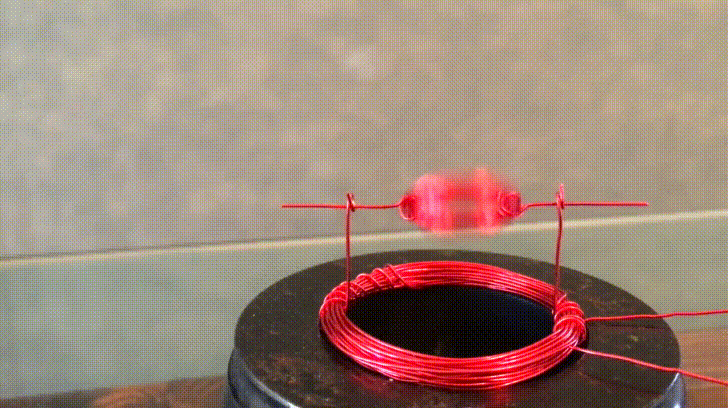Here’s a quick build to show off fundamentals of electric current to new makers — or a cool party trick that might earn you a buck. [Jay] from the [Plasma Channel] shows off how you can make a simple motor with only three pieces of enameled wire in under five minutes.
Start with a roll of 26-guage — or thicker — magnet wire, and a pair of scissors or knife. For the base, wrap fifteen to twenty turns of wire around any spherical object about one and a half inches in diameter, leaving a few inches extra on both ends. Wrap those ends around your coil a few tines to secure it and straighten out the excess length — one will act as a support and the other will connect to your power source. Another piece of wire — similarly wrapped around the base coil — acts as the other support and the other terminal. Scrape off the wire coating from one side on both support wires and curl them into small loops. Halfway done!
The spinning coil is made using the same method as the base, coiling it around a cylinder about a half an inch in diameter — scraping half the coating off each side once again — and inserted between the supports. Once a battery connects the two terminal ends, the electromagnetic fields of the two coils repel each other. As the spinning coil rotates, the wire coating breaks the circuit long enough to complete a revolution before beginning again. Cue applause from your rapt audience.
Again, this is a simple crash course, but the principles can be used to optimize any brushless motors or revive an ailing quadcopter.
















Spherical?
Why do you think it’s called a “motor(b)”? ;)
Couldn’t you do this with two pieces of wire?
I think in that case the big bottom coil would be turned on continuously which I’m not sure would work at all. With three wires the rotor will pulse both coils as it makes and breaks contact
The bottom coil CAN be powered continuously. You can use a permanent magnet instead. But cutting the current by putting it in series gives two advantages.
First it saves a little juice from the battery. On the other hand, the field now becomes strongest when the motor is running slow. This improves torque at low RPM and increases top speed at high RPM. Not sure if this motor achieves the efficiency required to start seeing that effect.
And a NE555?
Why don’t you just use an Arduino and drive it with PWM?
Or a pi, and drive it with sheer overpoweredness.
“For the base, wrap fifteen to twenty turns of wire around any spherical object about one and a half inches in diameter,”
Does it have to be spherical? Really? Surely a cylindrical former would work just as well.
Don’t sphere the wrapper?
so so very bad. terrible. boooo!
I liked it.
B^)
Put the word round in there.
Pretty good party trick. I was first thinking reversing current, but then I realized the on off would do.
But what about the marble base?
I made one of these in the 4th grade, in the late 70’s. It was extra credit, little guidance was given (intentionally), and few attempted. We used a permanent magnet at the base, rather than an electro. Power was via D-cells. I was the only person in the class to make it work.
That 4th grade teacher, a guy named John Walsh, was _the best_!
Nice.
Back in the Dark Ages, LIFE Magazine (ask your grandad about “magazines”) in one of their science books, published a small motor project which used a D cell, enamelled wire, 3 paperclips, scotch tape, and some thumbtacks to secure it all to a scrap of board. I was so pleased when I made one … and it worked!
But this one is even more minimalist, therefore cooler. Progress!
Here’s a quick build to show off fundamentals of electric current to new makers — or a cool party trick that might earn you a buck. [Jay] from the [Plasma Channel] shows off how you can make a simple motor with only THREE PIECES OF ENAMELED WIRE (Capitalization mine) in under 5 minutes.
Not to nit pick or anything but you need three pieces of wire and a BATTERY. Other than that, nice project.
The battery is only needed to make it turn. It’s still a motor without it.
The Hackaday comment section: where even the nitpickers have nitpickers. :)
I’m thinking of something to nitpick your comment with…
B^)
Need the nitwit to find a nitpick.
This was the first loboratory of electric motor on my engeeniering school.
We used a néodyme magnet for the base magnetic field.
My 20 minute version. Dont use old 7ah slab’s.
https://www.youtube.com/watch?v=lvVOEEFcjzQ
We use these to teach kids how motors work. Fun stuff.
I’m just trying to imagine what “or a cool party trick” might mean. So you’re hanging around with friends at a party. One of them does a trick where they manage to get a boiled egg into a bottle, or use a vacuum from burned paper to suck wine back into a glass, or whatever. You think “Oh, I know a great party trick” and ask the host if they have a roll of magnet wire, preferably 26 gauge. That’s one seriously nerdy party.